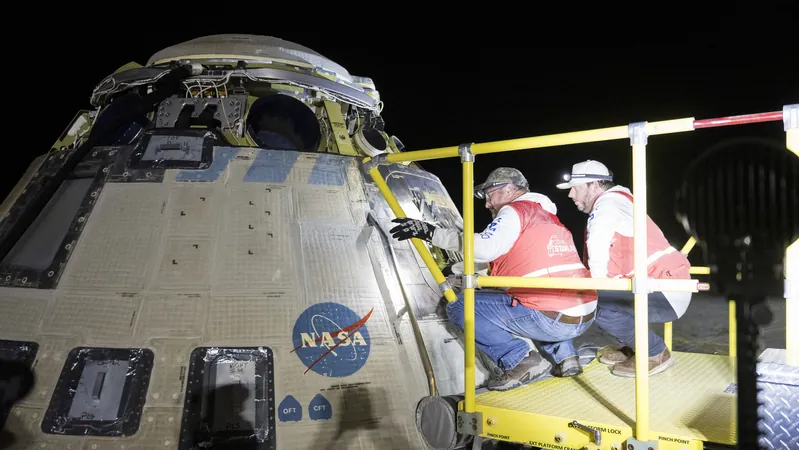
NASA's Grim Yet Prepared Response to Death in Space
2025-06-06
Author: Ying
Navigating the Final Frontier: NASA's Protocols for Astronauts' Deaths
As the boundaries of human exploration stretch into the cosmos, NASA is acutely aware of the tragedies that can befall its brave astronauts. While no mission has yet left an astronaut's remains floating in space, the agency has meticulously developed a strategy for the harrowing day that could occur.
At the heart of this somber protocol is the Human Remains Containment Unit (HRCU), a military-grade body bag designed specifically for the extreme conditions of the International Space Station (ISS). Introduced in 2012, the HRCU incorporates cutting-edge features aimed at preserving a body in the vacuum of space, much like a morgue uses refrigeration on Earth.
A Chilling Reality: The Functionality of the HRCU
This device operates through a refrigeration system on the ISS and is designed to hold its contents in a non-pressurized area, complete with absorbent lining and charcoal filters. NASA's protocol provides flight directors with a crucial 72-hour window to decide the next steps, demonstrating the agency's careful planning for even the most distressing scenarios.
Forensic Protocols in Space: A Unique Challenge
In the event of an astronaut's passing, the remaining crew members are trained to conduct In-Mission Forensic Sample Collection—a process that involves documenting the tragic event and collecting biological samples under the most challenging of circumstances, all while in communication with NASA's flight surgeons.
Honoring the Fallen: The Emotional Aftermath
After the grim task of collecting evidence, NASA provides a moment of ceremony for the crew to grieve, highlighting not just respect for the departed astronaut but also awareness of the impact on their mental health. A return to Earth would follow, where the HRCU can be strapped into the departed astronaut's seat for transport.
Looking Ahead: Future Possibilities
While a traditional burial in space poses challenges—most notably the risk of a floating body disrupting future missions—NASA remains open to imaginative solutions should deep-space missions become the norm. Could we see a ceremony reminiscent of Spock’s funeral in "Star Trek II: The Wrath of Khan"? Only time will tell.
A Wider Impact: The Societal Ramifications of Space Tragedy
NASA's thorough protocols extend beyond the crew’s grief; they are designed with societal impacts in mind. Each tragedy in space resonates deeply with the public, as demonstrated by the aftermath of the Apollo 1 disaster, which nearly derailed the program before it took flight.
Preparing for the Worst: Presidential Readiness
The weight of responsibility extends to the highest levels of government. In 1969, following the Apollo 1 incident, a heartfelt eulogy was prepared but ultimately never delivered. It began chillingly with, "Fate has ordained that the men who went to the moon to explore in peace will stay on the moon to rest in peace." This demonstrates the gravity of space exploration and the preparedness required not just for missions, but for the unexpected truths of human mortality.
A Continuing Vigilance in Space Exploration
Despite the safety measures and protocols in place, NASA's history is marked by tragedies, including the loss of the Space Shuttles Columbia and Challenger. With the expansion of commercial spaceflights and an increase in international missions, the potential for tragedy in orbit remains real, reminding us that the pursuit of exploration carries inherent risks.



 Brasil (PT)
Brasil (PT)
 Canada (EN)
Canada (EN)
 Chile (ES)
Chile (ES)
 Česko (CS)
Česko (CS)
 대한민국 (KO)
대한민국 (KO)
 España (ES)
España (ES)
 France (FR)
France (FR)
 Hong Kong (EN)
Hong Kong (EN)
 Italia (IT)
Italia (IT)
 日本 (JA)
日本 (JA)
 Magyarország (HU)
Magyarország (HU)
 Norge (NO)
Norge (NO)
 Polska (PL)
Polska (PL)
 Schweiz (DE)
Schweiz (DE)
 Singapore (EN)
Singapore (EN)
 Sverige (SV)
Sverige (SV)
 Suomi (FI)
Suomi (FI)
 Türkiye (TR)
Türkiye (TR)
 الإمارات العربية المتحدة (AR)
الإمارات العربية المتحدة (AR)